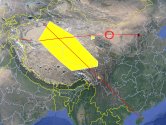You seem to be very confident about the warhead placements on Chinese ICBMs. What is the basis of your confidence?For China - and to some extent Russia as well - the quality of the deterrence matters more than the quantity alone, assuming the quantity is beyond certain threshold. China seems to realize that it was not a good idea to place too many RVs on TELs and have opted to diversify their deterrence by adding those few hundreds of silos, which is a significant investment, the ramification of which is not well perceived outside of ICs.
Why didn't they just add those RVs to DF-41 (or whatever came after) instead of going by the silo approach? was it because 41's capabilities in throw-weight or something else, like survivability?
Why did they place single-tipped DF-31BJ in the silos instead of a silo version of the DF-41?
Why did they produce a single-tipped DF-5C a few years after revealing the MIRV-ed 5B?
Behind closed doors there has to be careful deliberation within China's various bodies governing nuclear doctrines & strategic postures on these matters. Many things would affect the answers to these questions, including but not limited to the following:
- package of RVs currently available to produce besides the good old type 535, and whether the much smaller 575 is a real thing or not;
- technology/facilities available for LOW, which by now is most likely positive given the silos are being filled;
- willingness to participate arms control talks at some stage, and if so which models are likely to be used as chips on the table.
- what are the most threatening launchers the US can deploy against China, and what chips China is willing to offer in exchange to remove that threat. Some believe it is likely some sort of nuclear-tipped MRBM/IRBMs in those island chains, but we'll see.
You are using an out of date browser. It may not display this or other websites correctly.
You should upgrade or use an alternative browser.
You should upgrade or use an alternative browser.
China ICBM/SLBM, nuclear arms thread
- Thread starter Blitzo
- Start date
China not stopping until they get complete parity with US in terms of warhead count and launcher count.Ayi said that 1500 is a seriously underestimated figure, and he asked (jokingly) if they (the US) would adjust the figure to 2027 in 2030
My estimation: ~1000 in 2025(now), >2000 in 2030
View attachment 162356View attachment 162357
Ayi said that 1500 is a seriously underestimated figure, and he asked (jokingly) if they (the US) would adjust the figure to 2027 in 2030
My estimation: ~1000 in 2025(now), >2000 in 2030
They will likely adjust upward.
The 500->1000->1500 number is derived based on a set of assumptions from the 2019-2022 DOD[0], that China:
1) could only build up its nuclear stockpile to ~500 without new fissile material production
2) doesn't have enough production of tritium and plutonium to churn out nukes like USSR and US used to
[0] (p. 85)
You can probably extract tritium at the Qinshan Nuclear Power Plant. CANDU reactors use heavy water as moderator and tritium is generated by neutron capture.
Also from I understand it is possible to make nukes without any plutonium. Will just be less mass efficient.
Also from I understand it is possible to make nukes without any plutonium. Will just be less mass efficient.
Last edited:
China has one of the largest fleet of nuclear reactors in the world, they have all the plutonium they need coming from those reactors.You can probably extract tritium at the Qinshan Nuclear Power Plant. CANDU reactors use heavy water as moderator and tritium is generated by neutron capture.
Also from I understand it is possible to make nukes without any plutonium. Will just be less mass efficient.
China does lack a large Uranium reserve, but they import a lot and can easily make enough weapons grade uranium with a little bit of diversion from the imports.
The problem is separating plutonium for bombs from PWR spent fuel is very difficult. No one can do it. To produce weapons grade plutonium you need a reactor with easy access to the fuel.China has one of the largest fleet of nuclear reactors in the world, they have all the plutonium they need coming from those reactors.
Hence the CFR-600s and upcoming CFR-1000.The problem is separating plutonium for bombs from PWR spent fuel is very difficult. No one can do it. To produce weapons grade plutonium you need a reactor with easy access to the fuel.



